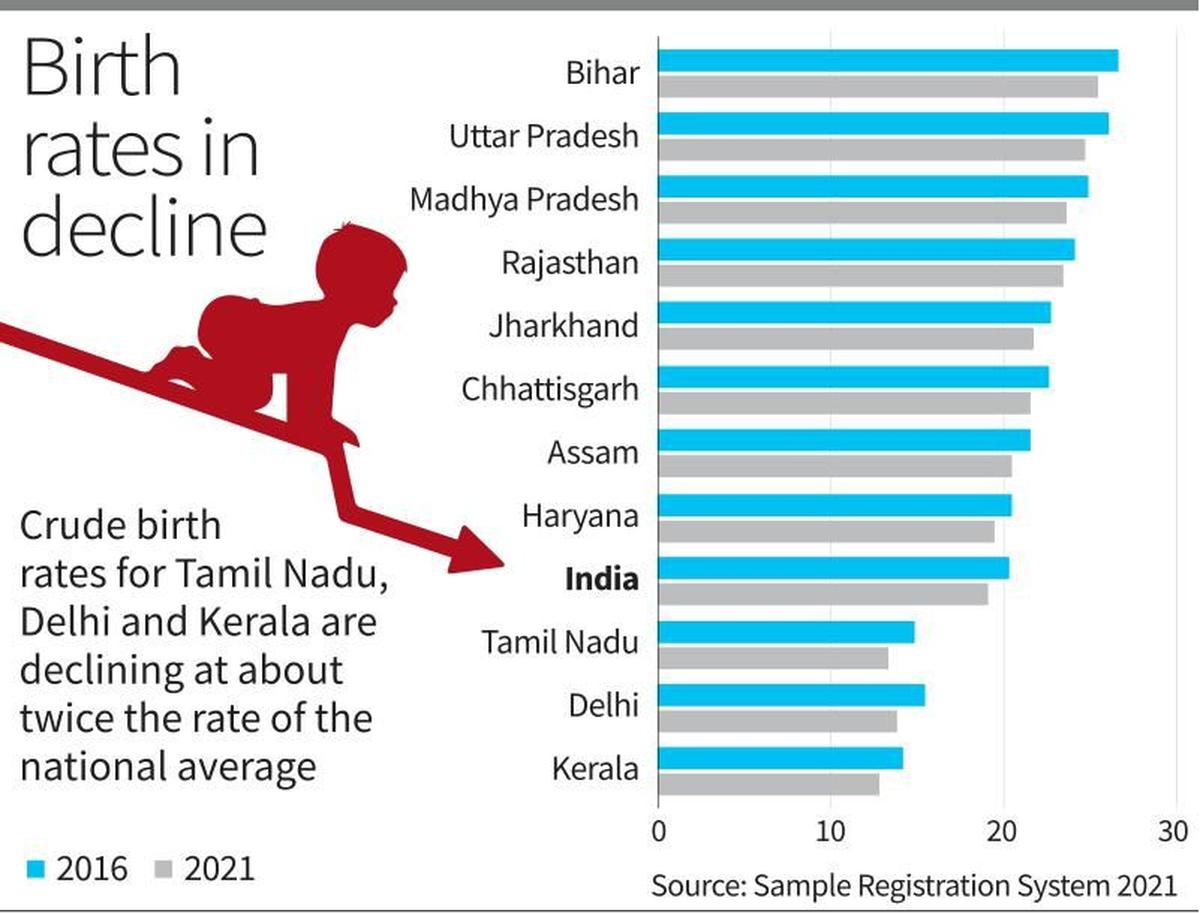Context:
The Sample Registration System (SRS) Statistical Report 2021 was released recently by the Registrar General of India, the Report highlights a significant demographic shift underway in India: a steady decline in birth rates across the country. While this trend is visible nationwide, the pace of decline varies sharply between states, with southern and urbanized regions witnessing the most rapid reductions.
Key findings:
National Overview:
The all-India crude birth rate—defined as the number of live births per 1,000 people—stood at 19.3 in 2021, declining at an annual rate of 1.12% from 2016 to 2021. This downward trend reflects changing fertility preferences, increasing urbanization, and improved access to healthcare and family planning.
Leaders in Decline:
Among the fastest-declining regions are:
- Tamil Nadu: Declining at 2.35% annually
- Delhi: 2.23%
- Kerala: 2.05%
Slow Movers:
In contrast, Rajasthan (0.48%), Bihar (0.86%), and Uttar Pradesh (1.09%) reported the slowest decline, indicating relatively high fertility and birth rates persisting in these regions.
Fertility Trends:
India’s TFR—the average number of children a woman is expected to have during her reproductive years—remained stable at 2.0 in 2021. However, disparities exist:
- Bihar: 3.0
- Uttar Pradesh: 2.7
- Madhya Pradesh: 2.6
- These figures exceed the replacement level fertility rate of 2.1, which is needed to maintain population stability.
Implications of Declining Birth Rates:
1. Changing Demographic Structure
As birth rates fall, India is gradually transitioning from a young to an aging population. This shift will have far-reaching consequences for labor markets, healthcare systems, and pension schemes in the coming decades.
2. Policy and Planning Challenges
Regions with high fertility may need continued investments in maternal and child health, while low-fertility areas must prepare for shrinking youth populations and rising dependency ratios.
3. Progress Toward SDGs
States like Kerala, Maharashtra, and Tamil Nadu, which are seeing rapid birth rate declines, have already met several United Nations Sustainable Development Goals (SDGs) related to maternal mortality (MMR), under-five mortality (U5MR), and neonatal mortality (NMR), showing the positive correlation between improved health outcomes and declining fertility.
Key terms:
Crude Birth Rate (CBR)
The number of live births per 1,000 people in a given year.
It provides a general indicator of fertility in the population but does not account for the age structure of the population.
Total Fertility Rate (TFR)
The average number of children a woman would have over her lifetime, assuming she experiences the current age-specific fertility rates throughout her reproductive years.
TFR = 2.1 → Replacement-level fertility in most developed countries (accounts for child mortality and gender imbalance).
Gross Reproduction Rate (GRR)
The average number of daughters a woman would have during her lifetime, assuming she survives through her reproductive years and current age-specific fertility rates remain constant.
Conclusion
India’s declining birth rates are a sign of socio-economic transformation, influenced by better education, urbanization, and access to healthcare. However, the uneven pace of change across states requires targeted policies to address regional disparities. As the country moves closer to population stabilization, these trends offer both challenges and opportunities in shaping India's demographic and economic future.







